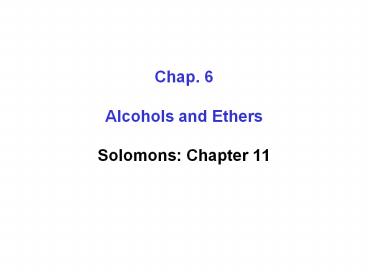Chap. 6 Alcohols and Ethers Solomons: Chapter 11 - PowerPoint PPT Presentation
Title:
Chap. 6 Alcohols and Ethers Solomons: Chapter 11
Description:
Title: Chapter 1--Title Author: F. G. West Last modified by: Yoshino Teruo Created Date: 5/15/2003 12:27:52 AM Document presentation format: – PowerPoint PPT presentation
Number of Views:138
Avg rating:3.0/5.0
Title: Chap. 6 Alcohols and Ethers Solomons: Chapter 11
1
Chap. 6Alcohols and EthersSolomons Chapter
11
2
- Physical Properties of Alcohols and Ethers
- Ether boiling points are roughly comparable to
hydrocarbons of the same molecular weight - Molecules of ethers cannot hydrogen bond to each
other - Alcohols have considerably higher boiling points
- Molecules of alcohols hydrogen bond to each other
- Both alcohols and ethers can hydrogen bond to
water and have similar solubilities in water - Diethyl ether and 1-butanol have solubilites of
about 8 g per 100 mL in water
3
?????????? 1.Alcohols from Alkenes
(??????????) 2.Hydroboration-Oxidation of
Akenes (??????)
4
- Synthesis of Alcohols from Alkenes
- Acid-Catalyzed Hydration of Alkenes
- This is a reversible reaction with Markovnikov
regioselectivity
5
- Hydroboration-Oxidation
- This addition reaction occurs with
anti-Markovnikov regiochemistry and syn
stereochemistry
6
?????????
- Conversion of Alcohols into Alkyl Halides
- Sulfonate??????????(SN2??)
7
- Conversion of Alcohols into Alkyl Halides
- Hydroxyl groups are poor leaving groups, and as
such, are often converted to alkyl halides when a
good leaving group is needed - Three general methods
8
- Alkyl Halides from the Reaction of Alcohols with
Hydrogen Halides - The order of reactivity is as follows
- Hydrogen halide HI gt HBr gt HCl gt HF
- Type of alcohol 3o gt 2o gt 1o lt methyl
- Mechanism of the Reaction of Alcohols with HX
- SN1 mechanism for 3o, 2o, allylic and benzylic
alcohols
9
- Primary and methyl alcohols undergo substitution
by an SN2 mechanism - Primary and secondary chlorides can only be made
with the assistance of a Lewis acid such as zinc
chloride
10
- Alkyl Halides from the Reaction of Alcohols with
PBr3 and SOCl2 - These reagents only react with 1o and 2o alcohols
in SN2 reactions - Reaction of phosphorous tribromide to give alkyl
bromides
11
- Reaction of thionyl chloride to give alkyl
chlorides - Often an amine is added to react with HCl formed
in the reaction
12
- Tosylates, Mesylates, and Triflates
- Leaving Group Derivatives of Alcohols
- The hydroxyl group of an alcohol can be converted
to a good leaving group by conversion to a
sulfonate ester - Sulfonyl chlorides are used to convert alcohols
to sulfonate esters - Base is added to react with the HCl generated
13
- A sulfonate ion (a weak base) is an excellent
leaving group - If the alcohol hydroxyl group is at a stereogenic
center then the overall reaction with the
nucleophile proceeds with inversion of
configuration - The reaction to form a sulfonate ester proceeds
with retention of configuration
14
Ethers
15
- Synthesis of Ethers
- Ethers by Intermolecular Dehydration of Alcohol
- Primary alcohols can dehydrate to ethers
- This reaction occurs at lower temperature than
the competing dehydration to an alkene - This method generally does not work with
secondary or tertiary alcohols because
elimination competes strongly
16
The mechanism is an SN2 reaction
17
- Williamson Ether Synthesis
- This is a good route for synthesis of
unsymmetrical ethers - The alkyl halide (or alkyl sulfonate) should be
primary - to avoid E2 reaction
- Substitution is favored over elimination at lower
temperatures
18
- tert-Butyl Ethers by Alkylation of Alcohols
Protecting Groups - This method is used to protect primary alcohols
- The protecting group is removed using dilute acid
19
- Silyl Ether Protecting Groups
- Silyl ethers are widely used protecting groups
for alcohols - The tert-butyl dimethysilyl (TBDMS) ether is
common - The protecting group is introduced by reaction of
the alcohol with the chlorosilane in the
presence of an aromatic amine base such as
imidazole or pyridine - The silyl ether protecting group is removed by
treatment with fluoride ion (e.g. from tetrabutyl
ammonium fluoride)
20
- Reactions of Ethers
- Acyclic ethers are generally unreactive, except
for cleavage by very strong acids to form the
corresponding alkyl halides - Dialkyl ethers undergo SN2 reaction to form 2
equivalents of the alkyl bromide
21
- Epoxides
- Epoxides are three-membered ring cyclic ethers
- These groups are also called oxiranes
- Epoxides are usually formed by reaction of
alkenes - with peroxy acids
- This process is called epoxidation and involves
syn addition of oxygen
22
- Magnesium monoperoxyphthalate (MMPP) is a common
and safe peroxy acid for epoxidation
23
- Reaction of Epoxides
- Epoxides are considerably more reactive than
regular ethers - The three-membered ring is highly strained and
therefore very reactive - Acid-catalyzed opening of an epoxide occurs by
initial protonation of the epoxide oxygen, making
the epoxide even more reactive - Acid-catalyzed hydrolysis of an epoxide leads to
a 1,2-diol
24
- In unsymmetrical epoxides, the nucleophile
attacks primarily at the most substituted carbon
of the epoxide
25
- Base-catalyzed reaction with strong nucleophiles
(e.g. an alkoxide or hydroxide) occurs by an SN2
mechanism - The nucleophile attacks at the least sterically
hindered carbon of the epoxide
26
- Anti 1,2-Dihydroxylation of Alkenes via Epoxides
- Opening of the following epoxide with water under
acid catalyzed conditions gives the trans diol



















![Building Success on: Industrial Oxo Alcohols Market Plan [2015 to 2020] PowerPoint PPT Presentation](https://s3.amazonaws.com/images.powershow.com/8854513.th0.jpg?_=20170612062)











